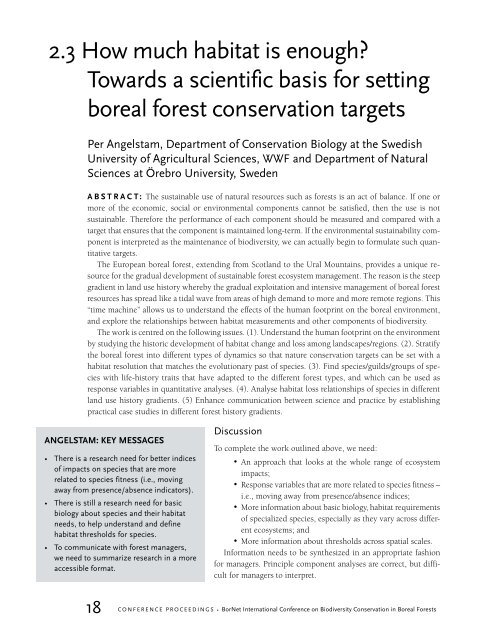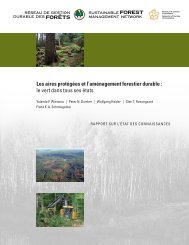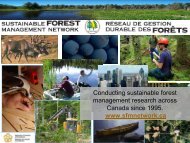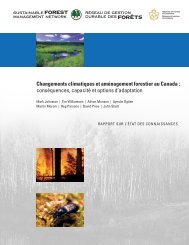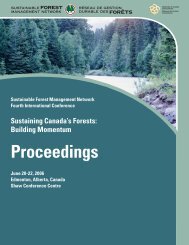Conference Proceedings - Sustainable Forest Management Network ...
Conference Proceedings - Sustainable Forest Management Network ...
Conference Proceedings - Sustainable Forest Management Network ...
You also want an ePaper? Increase the reach of your titles
YUMPU automatically turns print PDFs into web optimized ePapers that Google loves.
2.3 How much habitat is enough?<br />
Towards a scientific basis for setting<br />
boreal forest conservation targets<br />
Per Angelstam, Department of Conservation Biology at the Swedish<br />
University of Agricultural Sciences, WWF and Department of Natural<br />
Sciences at Örebro University, Sweden<br />
ABSTRACT: The sustainable use of natural resources such as forests is an act of balance. If one or<br />
more of the economic, social or environmental components cannot be satisfied, then the use is not<br />
sustainable. Therefore the performance of each component should be measured and compared with a<br />
target that ensures that the component is maintained long-term. If the environmental sustainability component<br />
is interpreted as the maintenance of biodiversity, we can actually begin to formulate such quantitative<br />
targets.<br />
The European boreal forest, extending from Scotland to the Ural Mountains, provides a unique resource<br />
for the gradual development of sustainable forest ecosystem management. The reason is the steep<br />
gradient in land use history whereby the gradual exploitation and intensive management of boreal forest<br />
resources has spread like a tidal wave from areas of high demand to more and more remote regions. This<br />
“time machine” allows us to understand the effects of the human footprint on the boreal environment,<br />
and explore the relationships between habitat measurements and other components of biodiversity.<br />
The work is centred on the following issues. (1). Understand the human footprint on the environment<br />
by studying the historic development of habitat change and loss among landscapes/regions. (2). Stratify<br />
the boreal forest into different types of dynamics so that nature conservation targets can be set with a<br />
habitat resolution that matches the evolutionary past of species. (3). Find species/guilds/groups of species<br />
with life-history traits that have adapted to the different forest types, and which can be used as<br />
response variables in quantitative analyses. (4). Analyse habitat loss relationships of species in different<br />
land use history gradients. (5) Enhance communication between science and practice by establishing<br />
practical case studies in different forest history gradients.<br />
ANGELSTAM: KEY MESSAGES<br />
• There is a research need for better indices<br />
of impacts on species that are more<br />
related to species fitness (i.e., moving<br />
away from presence/absence indicators).<br />
• There is still a research need for basic<br />
biology about species and their habitat<br />
needs, to help understand and define<br />
habitat thresholds for species.<br />
• To communicate with forest managers,<br />
we need to summarize research in a more<br />
accessible format.<br />
Discussion<br />
To complete the work outlined above, we need:<br />
• An approach that looks at the whole range of ecosystem<br />
impacts;<br />
• Response variables that are more related to species fitness –<br />
i.e., moving away from presence/absence indices;<br />
• More information about basic biology, habitat requirements<br />
of specialized species, especially as they vary across different<br />
ecosystems; and<br />
• More information about thresholds across spatial scales.<br />
Information needs to be synthesized in an appropriate fashion<br />
for managers. Principle component analyses are correct, but difficult<br />
for managers to interpret.<br />
18<br />
CONFERENCE PROCEEDINGS • BorNet International <strong>Conference</strong> on Biodiversity Conservation in Boreal <strong>Forest</strong>s


